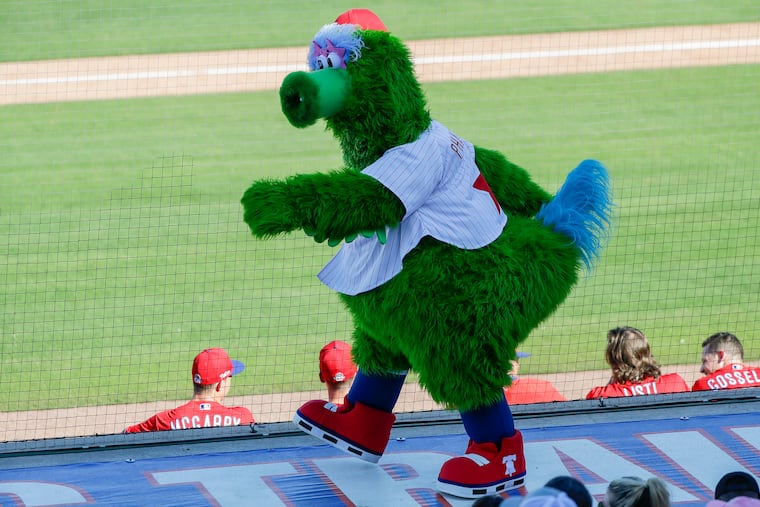Phillie Phanatic’s new look is a petty move to avoid paying artists | Opinion
It’s time the Phillies recognize their icon for what it is, and pay up to the original artists instead of bastardizing their design.

Though the Phils bested the Pittsburgh Pirates over the weekend, they did their own mascot and his creators downright dirty.
Last Friday, the Phillies alerted fans that things would look a little different when they took to the mound for Sunday’s spring training game. The Phanatic had undergone a minor glam-up. Something to do with socks, they teased.
Some stewed. Most simply shrugged at the nonannouncement. It’s not like the Phanatic of last season was identical to that scruffy young prospect of 1978, just off the boat from the Galápagos Islands.
Turns out, folks had little reason to worry. It takes some serious eye-spying to identify the subtle nips and tucks. He seems trimmer from certain angles. Huskier from others. He can still take what his mama gave him and thrust it toward a rival pitcher unsuspecting of his jelly. That party favor tongue still unfurls from an abbreviated snout. He can still shake his tail feathers, though they’re now a paler shade of blue.
So why make a big announcement and risk riling up a famously cynical crowd over what amounts to a series of minor cosmetic alterations?
Thing is, the conspicuous rollout wasn’t done for the fans; it was done to appease the courts.
The Phillies are currently embroiled in a legal battle involving the Phanatic. Granted, that’s frequently the status quo. (This time, it doesn’t center on the mascot throwing anyone into a pool.)
This time, the Phillies allege that the designers of the Phanatic have threatened, under current copyright laws, to make the mascot “a free agent” — meaning that the Phillies would not be allowed to use his image or likeness anywhere — unless terms of a 1984 agreement are renegotiated.
The Phillies seem to believe a tummy tuck and a new pair of socks can get them out of this dispute with Bonnie Erickson and Wayde Harrison, formerly of Acme Mascots. The team is hoping their changes are just enough to clear the legal loopholes that could require them to pay a hefty sum, without also alienating fans.
If it sounds like a tough needle to thread, it ought to be. Casting aside artists’ rights should make anyone look foolish, particularly an obscenely profitable organization. It’s petty and comes across as needlessly desperate.
Understand that the Phanatic didn’t simply cannonball into the Vet one afternoon. When the Phillies approached Jim Henson in 1977 to develop a new mascot to replace the impossibly dull Philadelphia Phil and Philadelphia Phillis, the overworked puppeteer pointed to a protégé, Erickson. Erickson had spent the past seven years managing Henson’s renowned Creature Shop, where she designed Miss Piggy and the heckling Statler and Waldorf. She imbued the puppets with personality and would do the same for the Phanatic.
In addition to developing character backgrounds, fabricating costumes, and training performers, the small firm led by Erickson and her husband, Harrison, handled promotion and merchandising, meaning their involvement continued well into the mascot’s career. Initially conceived as a fantasy creature, the living embodiment of a fan’s megaphone, the Philly Phanatic was a winning acquisition and netted a cool $2 million in merchandising his very first year. His popularity and profitability have snowballed over the decades.
Initially, the Phillies declined to buy the Phanatic’s copyright for a modest sum, preferring to lease the character. A far more costly deal was made in 1980 to purchase the rights in perpetuity, but Harrison/Erickson argue that relevant copyright law allows artists to revisit these contracts after 35 years. The Phillies attempt to downplay Erickson’s role in the Phanatic’s development, assigning more weight to that of the club’s then-vice president, Bill Giles.
By feigning to fix something that isn’t broken, the Phillies are putting another black eye on baseball. They’re no better than the Houston Astros, recently embroiled in a cheating scandal.
They should reach a settlement and pay Erickson and Harrison their due — not just because the Phanatic is the embodiment of hometown pride, but because it’s the right thing to do. There’s no case for buyer’s remorse here, no patience for a drawn-out custody battle. It’s time the Phillies recognize their icon for what it is, and pay up to the original artists instead of bastardizing their design. Our boy is worth every penny.
Paul Montgomery is a writer from Northeast Philadelphia.